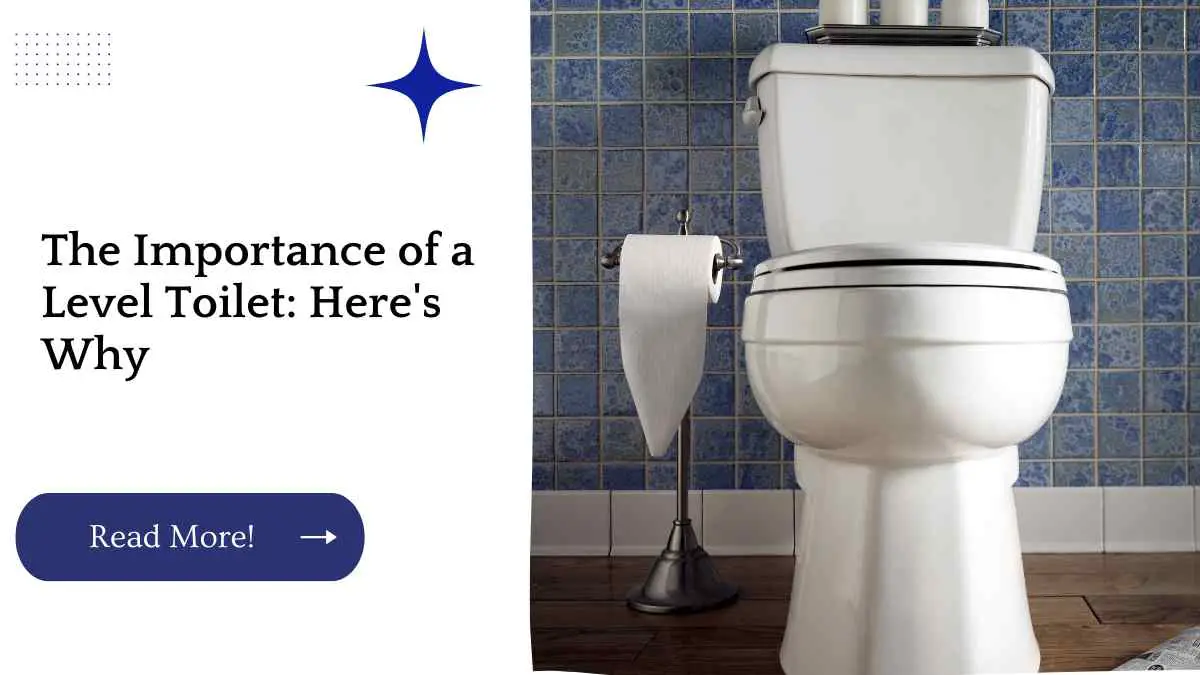A toilet is an essential fixture in any bathroom, and it’s easy to overlook its importance until something goes wrong. One of the most critical aspects of a toilet is its level. A level toilet is one that sits evenly on the bathroom floor, ensuring that it functions properly and doesn’t cause any damage or discomfort.
This blog post will explain why a level toilet is important, signs of an unlevel toilet, causes of an unlevel toilet, how to check the level of your toilet, how to level a toilet, hiring a professional plumber, DIY vs professional installation, and maintaining a level toilet.
| Key Takeaways |
|---|
| A level toilet is crucial for preventing leaks and damages, ensuring proper flushing, maintaining hygiene and cleanliness, improving comfort and safety, and enhancing the aesthetics of the bathroom. |
| Signs of an unlevel toilet include uneven water level, gurgling or bubbling noises, water leaks, and wobbling or rocking of the toilet. |
| Causes of an unlevel toilet include an uneven subfloor, improper installation, aging of the toilet, and changes in the foundation. |
| Regular inspection and maintenance, replacing old or damaged parts, and taking preventive measures can help maintain a level toilet and avoid future issues. |
| Hiring a professional plumber is recommended for proper installation and maintenance of the toilet. |
Why a Level Toilet is Important
A level toilet is crucial for several reasons, including:
Prevents leaks and damages
An unlevel toilet can cause leaks that damage the subfloor and the ceiling below the bathroom. Leaks can also lead to mold and mildew growth, which is harmful to your health and expensive to remediate.
When experiencing a rusted toilet flange, it’s crucial to know how to replace it properly. Follow our guide on how to replace a rusted toilet flange to ensure your toilet is functioning as it should be.
Ensures proper flushing
An unlevel toilet can cause improper flushing, resulting in waste accumulation and clogging. A level toilet ensures that water flows efficiently, flushing waste away without any issues.
Maintains hygiene and cleanliness
An unlevel toilet can lead to water pooling around the base of the toilet, creating an environment for bacteria and germs to thrive. A level toilet ensures that water flows efficiently into the bowl, minimizing the potential for bacteria growth.
Are you wondering if a toilet flange can be installed on top of the tile? Check out our article on toilet flange on top of tile to determine if this installation method is right for you.
Improves comfort and safety
An unlevel toilet can wobble or rock, making it uncomfortable and unsafe to use. A level toilet ensures that the toilet is stable and safe to use.
Enhances the aesthetics of the bathroom
An unlevel toilet can look unsightly and ruin the overall aesthetics of the bathroom. A level toilet ensures that the toilet sits evenly on the floor, enhancing the overall appearance of the bathroom.
Signs of an Unlevel Toilet
Several signs indicate that your toilet may be unlevel, including:
Uneven water level in the bowl
If the water level in the bowl is uneven, it may indicate that your toilet is unlevel.
Don’t let a faulty toilet shut-off valve ruin your day. Follow our tips for easy fixes for a toilet shut-off valve to prevent potential water damage in your home.
Gurgling or bubbling noises
Gurgling or bubbling noises when flushing the toilet may indicate that the toilet is not level, and the water is not flowing correctly.
Water leaks around the base
Water leaks around the base of the toilet are a clear sign that the toilet is unlevel and needs to be repaired.
Wobbling or rocking of the toilet
If the toilet wobbles or rocks when you sit on it, it is a clear indication that the toilet is unlevel.
Causes of an Unlevel Toilet
Several factors can cause your toilet to be unlevel, including:
Uneven subfloor
An uneven subfloor can cause the toilet to be unlevel. This is common in older homes, where the subfloor may have settled or shifted over time.
Improper installation
If the toilet was not installed correctly, it can be unlevel. This can be caused by incorrect measurements or not using the proper tools and materials.
Aging of the toilet
Over time, the toilet may shift or become unlevel due to wear and tear or changes in the foundation.
Changes in the foundation
Changes in the foundation, such as earthquakes or ground settling, can cause the toilet to become unlevel.
Maximize your relaxation and rejuvenation time in the bath with our hot water solutions guide. From water temperature control to improving water flow, we’ve got you covered.
How to Check the Level of Your Toilet
Checking the level of your toilet is a simple process that can be done with the following steps:
Using a level
Place a level on the back of the toilet tank and check if the bubble is in the center. If the bubble is off-center, the toilet is unlevel.
Checking for gaps between the toilet base and floor
Check for gaps between the toilet base and the bathroom floor. If there are gaps, the toilet is not level.
Using shims to level the toilet
If you have gaps between the toilet base and floor, you can use shims to level the toilet. Shims are small plastic or wooden wedges that can be inserted under the toilet to level it.
How to Level a Toilet
If your toilet is unlevel, you can level it with the following steps:
Removing the toilet
Turn off the water supply and flush the toilet to empty the bowl and tank. Remove the bolts securing the toilet to the floor and lift the toilet off the flange.
Leveling the subfloor
If the subfloor is uneven, use a self-leveling compound to level it. Follow the manufacturer’s instructions for the best results.
Water damage from a shower can be frustrating and costly to repair. Learn how to stop water damage and fix your shower’s drywall with our helpful tips and recommendations for sealing leaky showers
Installing shims
Place shims under the toilet to level it. Use a level to check that the toilet is even.
Reinstalling the toilet
Place the wax ring over the flange and reinstall the toilet. Tighten the bolts and reconnect the water supply.
Hiring a Professional Plumber
If you’re not comfortable installing or repairing a toilet, it’s best to hire a licensed and experienced plumber. A professional plumber has the skills and tools needed to ensure that your toilet is level and functions properly.
When hiring a plumber, look for a licensed professional with positive reviews and experience in toilet installation and repair. Ask for a quote before hiring them and make sure to ask any questions you may have about the process.
DIY vs Professional Installation
While DIY installation is possible, it’s not recommended unless you have experience and knowledge in toilet installation and repair. Professional installation ensures that the toilet is installed correctly and is level, reducing the risk of future issues.
If you’re considering DIY installation, make sure to do your research, watch tutorials, and have the necessary tools and materials. Be prepared for any issues that may arise and have a backup plan if needed.
Maintaining a Level Toilet
Regular inspection and maintenance are necessary to maintain a level toilet and prevent future issues. Some tips for maintaining a level toilet include:
Regular inspection and maintenance
Check your toilet regularly for any signs of damage or wear and tear. Replace any old or damaged parts as needed.
Replacing old or damaged parts
If your toilet is not flushing properly, it may be due to old or damaged parts. Replace any old or damaged parts as needed.
Preventive measures to avoid future issues
Avoid flushing non-biodegradable items, such as wipes or feminine hygiene products, down the toilet. These items can cause clogs and damage to your toilet.
Conclusion
A level toilet is essential for proper function, hygiene, comfort, and aesthetics. Signs of an unlevel toilet include uneven water level, gurgling or bubbling noises, water leaks, and wobbling or rocking of the toilet.
Causes of an unlevel toilet include an uneven subfloor, improper installation, aging of the toilet, and changes in the foundation. Maintaining a level toilet requires regular inspection and maintenance, replacing old or damaged parts, and taking preventive measures to avoid future issues.
Further Reading
Here are some additional resources for more information on the importance of a level toilet:
Why is it important to use a toilet? – Harpic: This article explains the importance of a toilet for hygiene and sanitation purposes, emphasizing the need for a level toilet.
Should Toilets Be Level? Here’s Why They Should – Kitchen Bed & Bath: This blog post delves into the reasons why a level toilet is important and the consequences of an unlevel toilet.
Does a Toilet Need to be Level? – Bath Advice: This article discusses the importance of a level toilet, how to check for an unlevel toilet, and the steps to level a toilet properly.
FAQs
1. What causes an unlevel toilet?
An unlevel toilet can be caused by an uneven subfloor, improper installation, aging of the toilet, and changes in the foundation.
2. How can I check the level of my toilet?
You can check the level of your toilet using a level, checking for gaps between the toilet base and floor, or using shims.
3. Why is a level toilet important?
A level toilet is important to prevent leaks and damages, ensure proper flushing, maintain hygiene and cleanliness, improve comfort and safety, and enhance the aesthetics of the bathroom.
4. Can I install a toilet myself?
While DIY installation is possible, it’s recommended to hire a licensed and experienced plumber for professional installation and maintenance of the toilet.
5. How do I maintain a level toilet?
Regular inspection and maintenance, replacing old or damaged parts, and taking preventive measures can help maintain a level toilet and avoid future issues.
6. How often should I inspect my toilet?
It’s recommended to inspect your toilet at least once a year to ensure that it’s functioning correctly and is level.
7. What preventive measures can I take to avoid future issues with my toilet?
Avoid flushing non-biodegradable items, such as wipes or feminine hygiene products, down the toilet. These items can cause clogs and damage to your toilet. Also, make sure to use a plunger or drain snake instead of harsh chemicals to unclog the toilet.
8. What should I do if my toilet is still unlevel after attempting to level it?
If your toilet is still unlevel after attempting to level it, it’s best to hire a professional plumber. A licensed and experienced plumber can assess the issue and provide the best solution.
9. Can an unlevel toilet cause other plumbing issues?
Yes, an unlevel toilet can cause other plumbing issues such as clogging, leaks, and damage to the subfloor and ceiling.
10. How long does it take to level a toilet?
The time it takes to level a toilet depends on the severity of the issue and whether or not a professional plumber is hired. On average, it can take a few hours to level a toilet properly.

Hellen James is the author of the blog and a licensed plumber with over 15 years of experience. She shares her knowledge and experience in plumbing and drainage through insightful and informative articles

